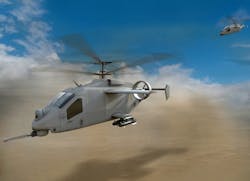AVX bets role in Future Attack Reconnaissance Aircraft (FARA) on new aviation technology and ducted fans
WASHINGTON – Dark horse design house AVX Aircraft Co. in Benbrook, Texas, has never built a complete aircraft. Competition for the U.S. Army Future Attack Reconnaissance Aircraft (FARA) just might change that. Breaking Defense reports. Continue reading original article
The Military & Aerospace Electronics take:
15 May -- Compared to its top competitors, aviation giants Sikorsky and Bell, AVX is innovative but small, like a hornet fighting eagles. A new partnership with the much larger L-3, however, more time to refine its aviation technology, and changing Army priorities all give AVX a better chance than the last time it took on its far larger rivals.
Ducted fans are the most visible trademark of AVX designs. Basically, they are rotors spinning inside a cylindrical cover, a propeller in a can. Arguably more efficient than conventional propellers and rotors at low speeds, but less efficient at high speeds, they’re used on the Navy’s LCAC hovercraft and off-the-shelf mini-drones.
AVX, however, likes to put them on high-speed aircraft — from its Joint Multi-Role candidate, to its plan to upgrade the aging OH-58 Kiowa, to its Future Attack Reconnaissance Aircraft proposal today. They give AVX’s designs a distinctly futuristic look, echoing gunships like James Cameron’s Avatar.
Related: Navy asks Bell to build 25 AH-1Z Viper attack helicopters and avionics for Marine Corps
John Keller, chief editor
